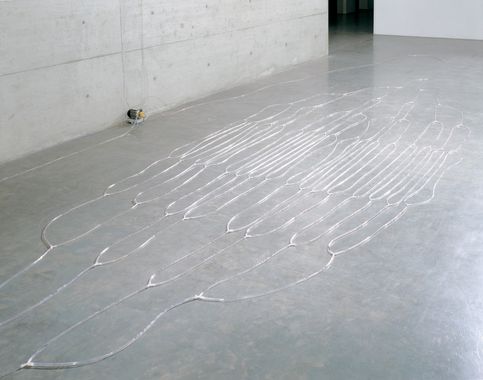Zirkulation

Hans Haacke
Zirkulation, 1969
Installation Vinyl tubes (PVC), ø 8, 11 and 14 mm, Y-connecting pieces, water, air, electric circulating pump Total dimensions variable Total dimensions of the version with 32 branchings, approx. 1100 x 380 cm Edition 1/3
GF0003069.00.0-2001
Artwork text
Symmetrical layout (see photo): the circulating pump (brass or other rust-proof material) and the greatest possible number of pairs of clear vinyl tubes are positioned in the symmetrical axis of the two equal halves of the system. The size of the exhibition space determines the length of the tube segments (100–200 cm) and their number. The tubes with the smallest diameter (0.5–0.8 cm) are located in the center. The diameter of the tubes increases gradually with the distance from the center, while their amount decreases. Two tubes of the largest diameter (1.0–1.4 cm) and significantly longer than the others, feed into the pump, one on each side. The number of tubes increases from the pump towards the center of the system according to the serial sequence 2, 4, 8, 16, 32, 64, 128… Plastic Y-connectors join pairs of tubes. When the transition from a smaller diameter to a larger diameter tube is to be accommodated, the end of the smaller diameter tube is to be heated in order for it to expand and made to fit onto the Y-connector with a larger diameter. Water must be clean and distilled. Growth of algae is to be prevented by the admixture of approx. 1/8 teaspoon of copper sulfate (very poisonous!) or another non-coloring and non-foaming chemical. In the process of filling the system with water, air bubbles must be introduced at regular, short intervals. Calibrating the power and speed of the motor, the choice of tubes with the appropriate diameter relative to their location in the system, and the speed of the flow of water (and consequently of the air bubbles) requires extensive experimentation. (Hans Haacke)